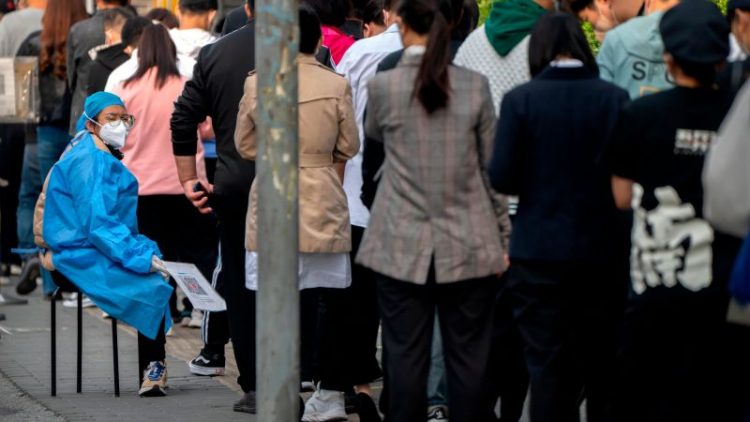CNN
—
A young woman stands on her balcony, crying out in desperation after her building was ordered into lockdown.
Fighting back tears, she shouts abuse at the hazmat-suited workers below in a video that has recently gone viral on social media platform Weibo and which appears to encapsulate the Chinese public’s growing frustration with their government’s uncompromising zero-Covid policy.
The woman has been under quarantine for half a year since returning from university in the summer, she shouts at the workers. They stare back, seemingly unmoved.
While most Asian economies – even those with previously hardline zero-Covid stances – are abandoning pandemic-era restrictions, authorities in China remain zealous in theirs, repeatedly insisting this week in state-run media articles that the battle against the virus remains “winnable.”
That claim comes even as infections flare and a new strain circulates just days before the country’s most important political event, the Communist Party Congress beginning in Beijing on Sunday at which Xi Jinping is expected to cement his place as the country’s most powerful leader in decades.
Observers across the world will be watching the twice-a-decade meeting for signs of the party’s priorities when it comes to its zero-Covid stance, which has been blamed for exacerbating mounting problems in the economy, from stalled growth to a collapsing housing market.
Nerves are high in China’s capital, where online photos posted Thursday appeared to show an exceptionally rare public protest against Xi. “Say no to Covid test, yes to food. No to lockdown, yes to freedom. No to lies, yes to dignity. No to cultural revolution, yes to reform. No to great leader, yes to vote. Don’t be a slave, be a citizen,” read one banner hung over an overpass despite the heightened security surrounding the Congress.
Yet all the signs are that even in the face of rising public discontent, Xi and his party plan to stick with the zero-Covid approach, possibly into 2023, with the state media articles this week serving to dampen speculation the country may change tack post-Congress.
More than 300 million people across dozens of cities in China had been affected by full or partial lockdowns at one point last month, according to CNN’s calculations.
But while the restrictions are lifted and imposed in response to local Covid outbreaks, the virus just keeps on reemerging.
And new outbreaks reported across the country this week suggest more misery could be on the way for China’s citizens – like the woman in the Weibo video – who have grown exhausted by a seemingly endless cycle of lockdowns.
China’s Health Commission on Thursday reported 1,476 locally transmitted Covid-19 cases nationwide, a significant number in a country where even one infection can trigger a city-wide lockdown.
In the northeastern province of Heilongjiang, 900,000 residents in Hegang city have been locked down since Friday after a single case was found.
In Shanghai, where 25 million people have already endured two months of the world’s strictest lockdown, residents are now on edge at any signs of a repeat as authorities begin to tighten measures once again.
The city reported 47 Covid-19 cases on Thursday, one day after authorities ordered six out of its 13 districts to shut entertainment venues such as internet cafes, cinemas and bars. Shanghai’s Disney resort has suspended some of its attractions and live performances since Sunday.
Spooked by the possibility of unpredictable and unannounced snap lockdowns – and mindful that authorities have previously backtracked after suggesting that no such measures were coming – some people in the city have reportedly been hoarding drinking water.
That panic buying has been made worse by an announcement that Shanghai’s water authorities have taken action to ensure water quality after discovering saltwater inflows to two reservoirs at the mouth of the Yangtze River in September.
Exactly what is driving the increase in infections is not clear, though authorities are scrambling to contain the spread of the BF.7 coronavirus strain after it was first detected in China in late September in Hohhot, the capital city of Inner Mongolia.
The country has also seen an uptick in cases in domestic tourist destinations, despite its strict curbs having discouraged people from traveling or spending over China’s Golden Week holiday in early October.
Hohhot logged 329 cases on Thursday, according to the National Health Commission, which now deems the remote region a high-risk hotspot.
More than 240,000 university students in Inner Mongolia have been locked down on campuses due to the latest outbreak, according to Zhang Xiaoying, a deputy director of the regional Department of Education. And the outbreak on campus has led to punitive action, with one university Communist Party boss being sacked after 39 students from his institution tested positive.
Then there is the situation in far western Xinjiang, where some 22 million people have been banned from leaving the region and are required to stay home. Xinjiang recorded 403 new cases on Thursday, according to an official tally.
Yet amid it all, Beijing appears unwilling to move from its hardline stance. For three days this week, the state-run Communist Party mouthpiece People’s Daily published commentaries reiterating that China would not let its guard down.
“Lying flat is not advisable,” it said in its third commentary, on Wednesday, referring to a Chinese phrase that denotes complacency.
The battle against Covid was winnable, it insisted. Other countries that had reopened and eased restrictions had done so because they had no choice, it said, as they had failed to “effectively control the epidemic in a timely manner.”
Source by www.cnn.com





























